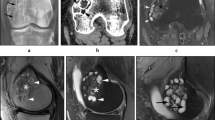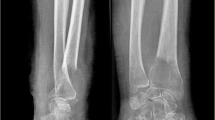Abstract
Some primary malignant or benign tumours of bone contain numerous multinucleated cells. These “giant cell-rich tumours of bone” have overlapping features and clinical and radiological data are needed to reach an accurate pathological diagnosis. We studied the potential contribution of p63 immunohistochemistry to the reliability of the histological diagnosis. We performed a multicentric retrospective study of 291 giant cell-rich tumours of bone which included 119 giant cell tumours of bone (GCTB), 76 aneurysmal bone cysts (ABC), 49 chondroblastomas (CB), 15 nonossifying fibromas (NOF), 10 giant cell reparative granulomas (RG) of jaws, 1 giant cell lesion of small bones, 2 hyperparathyroidism-related brown tumours (BT), 17 bone sarcomas with numerous osteoclasts and 2 malignant giant cell tumours of bone. p63 is expressed in ABC, CB, NOF, RG, BT and GCTB, but its expression in more than 50 % of mononuclear cells is strongly suggestive of a diagnosis of GCTB. In contrast, malignant GCTB were mostly negative. Our results show that p63 is expressed in a broad range of benign giant cell-rich tumours of bone, consistent with data in the recent literature, while infrequent in malignant tumours. With a cut-off 50 %, the presence of p63 positive cells is useful in supporting a diagnosis of giant cell-rich tumour of bone. However, a final diagnosis cannot be made without due consideration of all clinical/radiological and pathological data.





Similar content being viewed by others
References
Bertoni F, Bacchini P, Staals EL (2003) Malignancy in giant cell tumor. Skelet Radiol 32:143–6. doi:10.1007/s00256-002-0550-8
Fletcher, C. D.M., Bridge, J.A., Hogendoorn, P., Mertens F (2013) WHO Classification of Tumours of Soft Tissue and Bone, 4th edn Edition. IARC
Werner M (2006) Giant cell tumour of bone: morphological, biological and histogenetical aspects. Int Orthop 30:484–9. doi:10.1007/s00264-006-0215-7
Dickson BC, Li S-Q, Wunder JS et al (2008) Giant cell tumor of bone express p63. Mod Pathol 21:369–75. doi:10.1038/modpathol.2008.29
Lee C-H, Espinosa I, Jensen KC et al (2008) Gene expression profiling identifies p63 as a diagnostic marker for giant cell tumor of the bone. Mod Pathol 21:531–9. doi:10.1038/modpathol.3801023
Westfall MD, Pietenpol J (2004) p63: molecular complexity in development and cancer. Carcinogenesis 25:857–64. doi:10.1093/carcin/bgh148
Di Como CJ, Urist MJ, Babayan I, et al. (2002) p63 expression profiles in human normal and tumor tissues. 8:494–501.
Paner GP, Luthringer DJ, Amin MB (2008) Best practice in diagnostic immunohistochemistry: prostate carcinoma and its mimics in needle core biopsies. Arch Pathol Lab Med 132:1388–96. doi: 10.1043/1543-2165(2008)132[1388:BPIDIP]2.0.CO;2
Yanagisawa M, Kakizaki H, Okada K et al (2013) p63 as a prognostic marker for giant cell tumor of bone. Ups J Med Sci 118:23–8. doi:10.3109/03009734.2012.724731
De La Roza G (2011) p63 expression in giant cell-containing lesions of bone and soft tissue. Arch Pathol Lab Med 135:776–779
Hammas N, Laila C, Youssef ALM et al (2012) Can p63 serve as a biomarker for giant cell tumor of bone? A Moroccan experience. Diagn Pathol 7:130. doi:10.1186/1746-1596-7-130
Monda L, Wick MR (1985) S-100 protein immunostaining in the differential diagnosis of chondroblastoma. Hum Pathol 16:287–93
Konishi E, Nakashima Y, Iwasa Y et al (2010) Immunohistochemical analysis for Sox9 reveals the cartilaginous character of chondroblastoma and chondromyxoid fibroma of the bone. Hum Pathol 41:208–13. doi:10.1016/j.humpath.2009.07.014
Hemingway F, Kashima TG, Mahendra G et al (2012) Smooth muscle actin expression in primary bone tumours. Virchows Arch 460:525–34. doi:10.1007/s00428-012-1235-x
Panoutsakopoulos G (1999) Recurrent t(16; 17)(q22; p13) in aneurysmal bone cysts. Genes Chromosom Cancer 26:265–266
Oliveira M (2004) USP6 (Tre2) fusion oncogenes in aneurysmal bone cyst. Cancer Res 64:1920–1923. doi:10.1158/0008-5472.CAN-03-2827
Oliveira AM, Perez-Atayde AR, Inwards CY et al (2004) USP6 and CDH11 oncogenes identify the neoplastic cell in primary aneurysmal bone cysts and are absent in so-called secondary aneurysmal bone cysts. Am J Pathol 165:1773–80. doi:10.1016/S0002-9440(10)63432-3
Oliveira AM, Perez-Atayde AR, Dal Cin P et al (2005) Aneurysmal bone cyst variant translocations upregulate USP6 transcription by promoter swapping with the ZNF9, COL1A1, TRAP150, and OMD genes. Oncogene 24:3419–26. doi:10.1038/sj.onc.1208506
Park H-R, Kim Y-W, Park J-H et al (2004) Low expression of p63 and p73 in osteosarcoma. Tumori 90:239–243
Kallen ME, Sanders ME, Gonzalez AL et al (2012) Nuclear p63 expression in osteoblastic tumors. Tumour Biol 33:1639–1644. doi:10.1007/s13277-012-0419-y
Estrada EG, Ayala AG, Lewis V, Czerniak B (2002) Dedifferentiated chondrosarcoma with a noncartilaginous component mimicking a conventional giant cell tumor of bone. Ann Diagn Pathol 6:159–163
Huang J, Jiang Z, Yang Q, Zhang H (2013) Benign looking giant cell component in dedifferentiated chondrosarcoma: benign or malignant? A case report. Int J Surg Pathol 21:48–53. doi:10.1177/1066896912451322
Alberghini M, Kliskey K, Krenacs T et al (2010) Morphological and immunophenotypic features of primary and metastatic giant cell tumour of bone. Virchows Arch an Int J Pathol 456:97–103
Lau CPY, Ng PKS, Li MS et al (2013) p63 regulates cell proliferation and cell cycle progression-associated genes in stromal cells of giant cell tumor of the bone. Int J Oncol 42:437–43. doi:10.3892/ijo.2012.1727
Acknowledgments
The tumour specimens in Marseille were retrieved from the pathological files of the APHM Biobank (authorized number AC-2013-1786).
This work was supported by institutional grants from the Department of Pathology of the Timone Hospital and UMR 911 (AMU).
Conflict of interest
The authors declare no conflict of interest.
Author information
Authors and Affiliations
Corresponding author
Additional information
André Maues De Paula and Alexandre Vasiljevic equally contributed to the work
Rights and permissions
About this article
Cite this article
Maues De Paula, A., Vasiljevic, A., Giorgi, R. et al. A diagnosis of giant cell-rich tumour of bone is supported by p63 immunohistochemistry, when more than 50 % of cells is stained. Virchows Arch 465, 487–494 (2014). https://doi.org/10.1007/s00428-014-1637-z
Received:
Revised:
Accepted:
Published:
Issue Date:
DOI: https://doi.org/10.1007/s00428-014-1637-z




